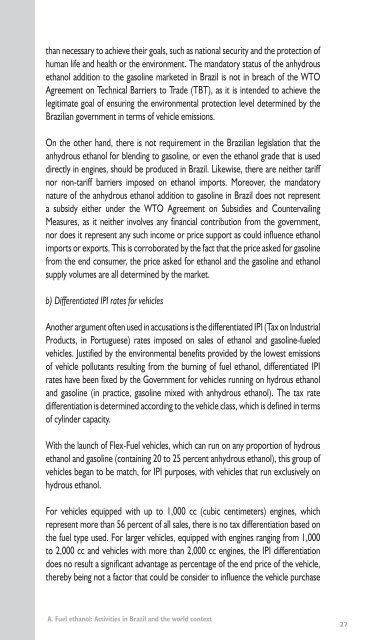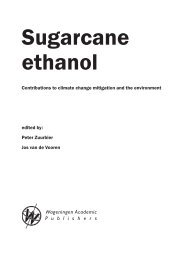Production and use of fuel ethanol in Brazil - BAFF
Production and use of fuel ethanol in Brazil - BAFF
Production and use of fuel ethanol in Brazil - BAFF
Create successful ePaper yourself
Turn your PDF publications into a flip-book with our unique Google optimized e-Paper software.
than necessary to achieve their goals, such as national security <strong>and</strong> the protection <strong>of</strong><br />
human life <strong>and</strong> health or the environment. The m<strong>and</strong>atory status <strong>of</strong> the anhydrous<br />
<strong>ethanol</strong> addition to the gasol<strong>in</strong>e marketed <strong>in</strong> <strong>Brazil</strong> is not <strong>in</strong> breach <strong>of</strong> the WTO<br />
Agreement on Technical Barriers to Trade (TBT), as it is <strong>in</strong>tended to achieve the<br />
legitimate goal <strong>of</strong> ensur<strong>in</strong>g the environmental protection level determ<strong>in</strong>ed by the<br />
<strong>Brazil</strong>ian government <strong>in</strong> terms <strong>of</strong> vehicle emissions.<br />
On the other h<strong>and</strong>, there is not requirement <strong>in</strong> the <strong>Brazil</strong>ian legislation that the<br />
anhydrous <strong>ethanol</strong> for blend<strong>in</strong>g to gasol<strong>in</strong>e, or even the <strong>ethanol</strong> grade that is <strong>use</strong>d<br />
directly <strong>in</strong> eng<strong>in</strong>es, should be produced <strong>in</strong> <strong>Brazil</strong>. Likewise, there are neither tariff<br />
nor non-tariff barriers imposed on <strong>ethanol</strong> imports. Moreover, the m<strong>and</strong>atory<br />
nature <strong>of</strong> the anhydrous <strong>ethanol</strong> addition to gasol<strong>in</strong>e <strong>in</strong> <strong>Brazil</strong> does not represent<br />
a subsidy either under the WTO Agreement on Subsidies <strong>and</strong> Countervail<strong>in</strong>g<br />
Measures, as it neither <strong>in</strong>volves any f<strong>in</strong>ancial contribution from the government,<br />
nor does it represent any such <strong>in</strong>come or price support as could <strong>in</strong>fluence <strong>ethanol</strong><br />
imports or exports. This is corroborated by the fact that the price asked for gasol<strong>in</strong>e<br />
from the end consumer, the price asked for <strong>ethanol</strong> <strong>and</strong> the gasol<strong>in</strong>e <strong>and</strong> <strong>ethanol</strong><br />
supply volumes are all determ<strong>in</strong>ed by the market.<br />
b) Differentiated IPI rates for vehicles<br />
Another argument <strong>of</strong>ten <strong>use</strong>d <strong>in</strong> accusations is the differentiated IPI (Tax on Industrial<br />
Products, <strong>in</strong> Portuguese) rates imposed on sales <strong>of</strong> <strong>ethanol</strong> <strong>and</strong> gasol<strong>in</strong>e-<strong>fuel</strong>ed<br />
vehicles. Justified by the environmental benefits provided by the lowest emissions<br />
<strong>of</strong> vehicle pollutants result<strong>in</strong>g from the burn<strong>in</strong>g <strong>of</strong> <strong>fuel</strong> <strong>ethanol</strong>, differentiated IPI<br />
rates have been fixed by the Government for vehicles runn<strong>in</strong>g on hydrous <strong>ethanol</strong><br />
<strong>and</strong> gasol<strong>in</strong>e (<strong>in</strong> practice, gasol<strong>in</strong>e mixed with anhydrous <strong>ethanol</strong>). The tax rate<br />
differentiation is determ<strong>in</strong>ed accord<strong>in</strong>g to the vehicle class, which is def<strong>in</strong>ed <strong>in</strong> terms<br />
<strong>of</strong> cyl<strong>in</strong>der capacity.<br />
With the launch <strong>of</strong> Flex-Fuel vehicles, which can run on any proportion <strong>of</strong> hydrous<br />
<strong>ethanol</strong> <strong>and</strong> gasol<strong>in</strong>e (conta<strong>in</strong><strong>in</strong>g 20 to 25 percent anhydrous <strong>ethanol</strong>), this group <strong>of</strong><br />
vehicles began to be match, for IPI purposes, with vehicles that run exclusively on<br />
hydrous <strong>ethanol</strong>.<br />
For vehicles equipped with up to 1,000 cc (cubic centimeters) eng<strong>in</strong>es, which<br />
represent more than 56 percent <strong>of</strong> all sales, there is no tax differentiation based on<br />
the <strong>fuel</strong> type <strong>use</strong>d. For larger vehicles, equipped with eng<strong>in</strong>es rang<strong>in</strong>g from 1,000<br />
to 2,000 cc <strong>and</strong> vehicles with more than 2,000 cc eng<strong>in</strong>es, the IPI differentiation<br />
does no result a significant advantage as percentage <strong>of</strong> the end price <strong>of</strong> the vehicle,<br />
thereby be<strong>in</strong>g not a factor that could be consider to <strong>in</strong>fluence the vehicle purchase<br />
A. Fuel <strong>ethanol</strong>: Activities <strong>in</strong> <strong>Brazil</strong> <strong>and</strong> the world context<br />
27












